Well, well, well, Winter. We meet again! The first time I had to deal with winter weather in Mississippi was February of 2015 behind a bout of severe weather. The last time? January 4, 2016 when we ended up with some ice, and not much – if any – snow.
The last time the area had winter weather, I tried to explain the chance for snow as…
The chance that the precipitation falls as snow depends on (1) where you are, (2) where the area of lowest pressure moves, (3) how fast the cold air pushes south, (4) how deep the cold air is, (5) the direction vector of the moisture plume, (6) if the over-riding southwest flow is moist enough at the right levels, (7) if the dendritic growth zone can become saturated, and (8) the wet-bulb temperature through the profile.
As well as a handful of other factors like (9) 500mb vorticity location, (10) 700mb vertical velocity, and (11) 200mb divergence.
Oh, and (12) if all of these things can happen in the (12a) right amounts (12b) at the right time (12c) in the right place and (12d) you are in that place and (12e) looking for it.
So you can imagine, as a meteorologist, how I am preparing to be “wrong” for everyone. Literally. Every. One.
Still holds true, for the most part. And I, again, plan on being wrong for everyone.
Literally. Every. One.

Okay, okay. Taking a cue from the tropical discussions I wrote over the summer, here is a look at what we know, what we don’t know and what we can’t know. As well as the forecast for right now at the end.
What we know
1. It’s going to feel cold.
Afternoon highs during the next few days will be in the mid to upper 40s in the afternoon. Overnight lows will be int he mid 30s Thursday morning and around the freezing mark Friday morning. That means that a good chunk of the day will be below 40 degrees.
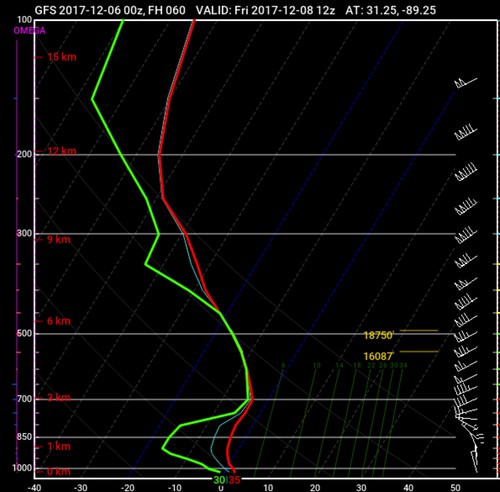
It will feel very cold.
But feeling cold and being cold enough for snow are two different things. So let’s look at the data.
The Skew-T image posted is a look at the atmosphere on Friday morning.
The Skew-T shows that the atmosphere will be below freezing from the top all the way to just above the surface. That means that if we do get an precipitation – at least, according to this model – it would likely be in an atmosphere that is below freezing from the time it formed until the time it hit the ground.
2. There will be precipitation
But it isn’t that easy, just because it is below freezing and there is moisture doesn’t mean we automatically get snow. In order for snow to grow, you need to have a saturated Dendritic Growth Zone. That’s because most of the cloud droplets are still composed of liquid water even when the temperature is below freezing. When water droplets (different than cloud droplets) exist below freezing, they are called “supercooled” droplets. In the subfreezing air of a cloud, many supercooled liquid droplets will surround each ice crystal and freeze to it. But there aren’t as many as there are water droplets, so this process can take some time to create a LOT of ice and/or snow.
But back to the Skew-T.
The red line and green line are close to each other above the 700mb line (10,000ft). That indicates that the atmosphere is saturated. And it is saturated in the Dendritic Growth Zone (DGZ). But, sSince the red and green line aren’t close to each other below – roughly – 10,000 feet, it means that any precipitation that may form higher up in the atmosphere, may evaporate/sublimate before reaching the surface.
3. Both above things will be true, simultaneously
I think it is a safe bet that someone, somewhere in Mississippi or Alabama will see wintry precipitation.
4. Weather models don’t handle snowfall estimates very well
This is one of the biggest problems for meteorologists. Forecast models stink at figuring out who will see snow and who will not see snow. They use an algorithm to decipher how much snow will fall based on the ratio of 1 inch of rain is equal to 10 inches of snow. And if the atmosphere is below freezing from top to bottom, it assumes everything will be snow, and BAM, instant snowfall map.
But, as we noted above, that that isn’t terribly accurate.
Yet, what is the easiest thing in the world for people to do? Find a model and post a snowfall map to social media, where it is shared a million times.
Like this map, for example:
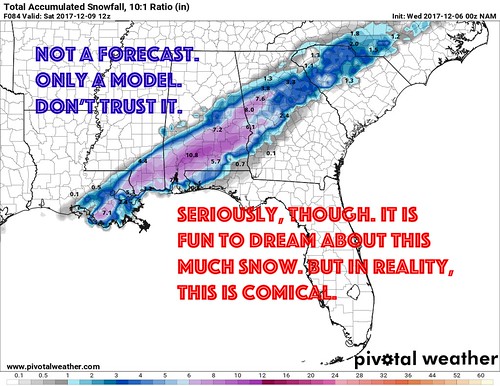
Like, c’mon. Really? No way.
Without getting into the weeds, too much, the model shown there also breaks off an area of low pressure and moves it through a full 18 hours later than every other model. And as it moves through, increases lift and, in turn, saturated the DGZ, creating a place to create snowflakes.
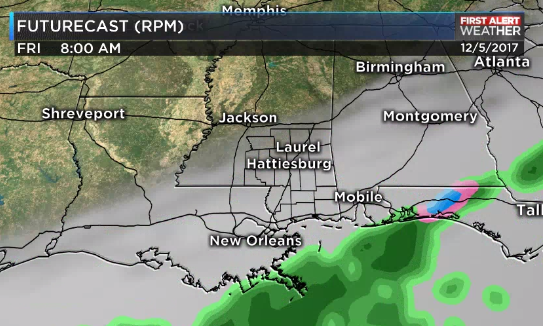
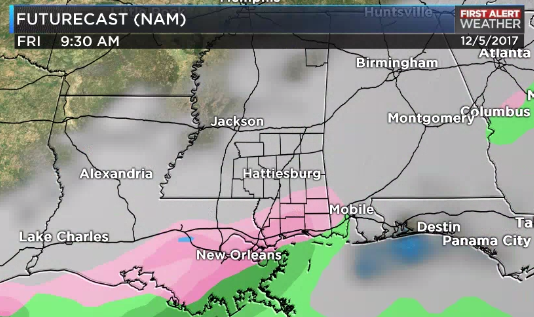
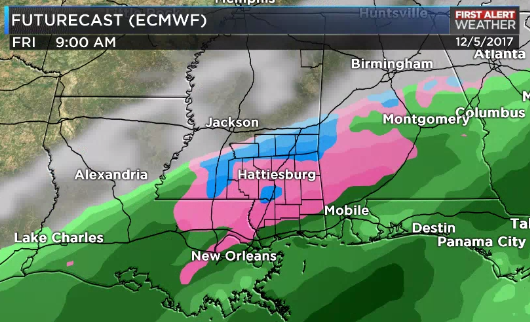
Note the differences between the maps. Between the 8am and 10am hours on Friday morning, the RPM has us dry, the NAM says a mix of rain and sleet, the ECMWF has a mix of sleet and snow. We know models are not going to handle snowfall maps well, and the proof is in the puddin’. Instead, meteorologists look at a TON of other parameters and data to figure out if it will snow or not.
5. This isn’t Ohio
If we were in a northern state, this forecast would not be as tricky, but given our proximity to the – very warm – Gulf of Mexico, it makes snow very difficult to forecast.
What we don’t know
1. How the secondary push of atmospheric energy will develop
This is probably the biggest key to this whole mess.
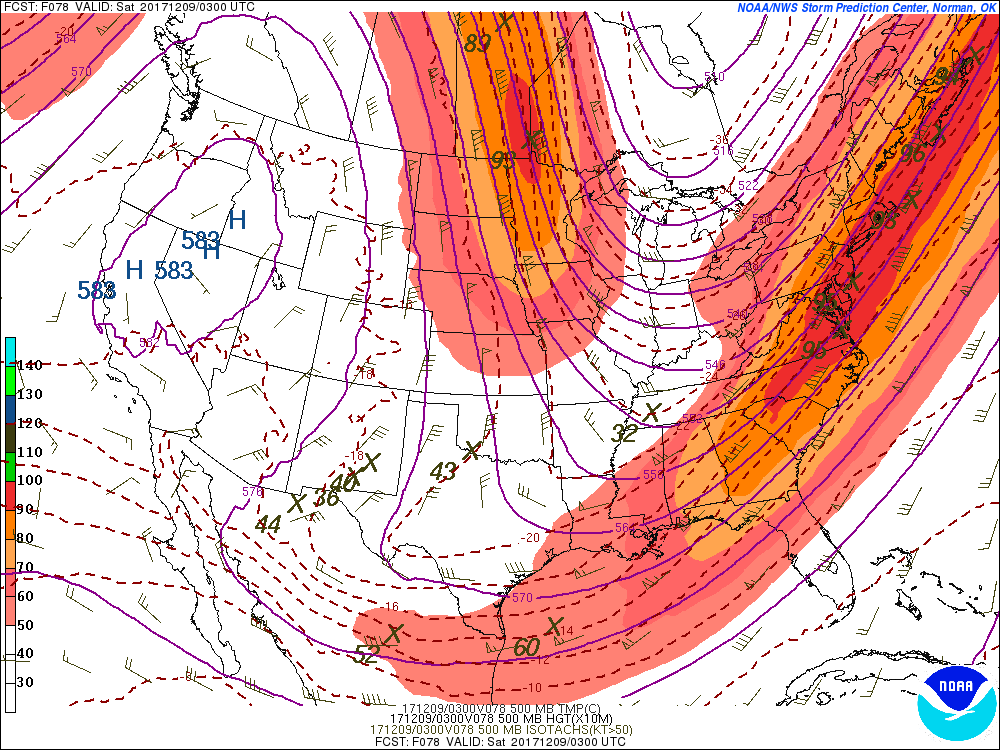
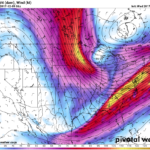
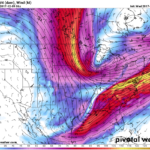
The three images above illustrate that the best. Notice all of the differences between the isobars and the winds? Those small differences will have a large impact on the final precipitation type. Knowing that is the first domino in the chain of ‘snowfall forecasting’ with any accuracy. And we won’t know about it until – at the soonest – Wednesday night. But mostly likely, we won’t know until Thursday morning.
Once we know how this is going to shake out, we can start to knock out everything else. And we won’t know what the secondary push looks like until after the initial batch of rain moves through the area on Wednesday.
2. How hard the precipitation (whatever it is) will be falling
Getting snow to fall all the way to the surface along the Gulf Coast – generally – takes heavier precipitation than places further north. The reason? You have to overcome either (a) a warm layer between the snow high up in the cloud and the ground, (b) a dry layer between the snow high up in the cloud and the ground, or (c) a both warm and dry layer between the snow high up in the cloud and the ground.
If there isn’t much forcing in the atmosphere and the precipitation falls as drizzle or very light rain, we may not get snow to fall.
3. Specifically when, where and how much snow will happen
Weather prediction is tough. Snowfall prediction is tougher. Snowfall prediction in the south is even tougher. Snowfall prediction in the south three days out is even tougher, still. Snowfall prediction in the south, three days out, for specific places, towns and individual houses is impossible.
I wish I had a Magic Ball I could look into to find out this info, but is simply doesn’t exist. And anyone prognosticating that there will or won’t be snow in a certain place or at a specific time is full of it. Anyone that starts to put out accumulation estimates? Avoid them.
What we can’t know
Due to the distance between forecast points (we call that “resolution” in the weather world) on the forecast models, we can’t know if it will snow specifically at your house more than 12 hours out along the Gulf Coast. And even that is a stretch.
Just like with severe weather and hurricanes, the closer we get in time, the more and more we know about the forecast. We can offer more and more specifics the closer we get. But for now, we can’t know if you, specifically, will see snow.
The bottom line forecast
It is going to be pretty chilly Wednesday, Thursday and Friday. Afternoon highs will struggle to get past 45 in the afternoon. And depending on the rain, it may be cooler than that.
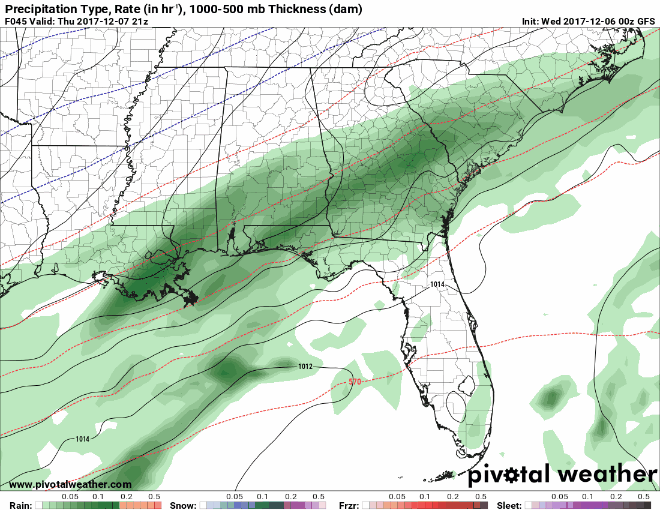
Overnight lows will likely dip down to the freezing mark – or just above it. The more rain we get, the warmer it will be. The drier we are, the cooler the overnight lows will get.
The GIF posted is what the GFS thinks will happen. It says a good cold rain for Wednesday, and Thursday and dry by Friday. And I tend to lean more toward that than anything else at this time.
So here is a quick look at a brief forecast:
Wednesday: Morning showers and drizzle followed by more afternoon drizzle and light rain. Highs around 45
Thursday: Morning drizzle and light rain easing back to just patchy showers in the afternoon. Highs around 48
Friday: Morning showers with a wintry mix possible. Dry by afternoon. Highs around 45.
This forecast is likely to change, and we will know more and more about what to expect with each new model run. So please keep an eye on the forecast in the coming days!
IN THE FUTURE!
12/6/23 UPDATE: Boy, oh boy did I learn a lot about forecasting snow in the South from this event! I actually made a whole post about it. You can read it here.
I wanted to share a TV forecast (from 12/7/17) about this snowfall event. I didn’t quite get it right 24 hours after this post, either.
At this point, I got the bullseye for where the most snow would fall, but didn’t have the totals correct. Part of the reason for that was underestimating just how quick we would change-over to snow.
If you want to see the discussion about this snowfall event that we had on facebook before the newscast, you can check this out:
Then it started snowing overnight, and this is how it looked on the morning of December 8th:
A lot more snow than anticipated, for certain.

